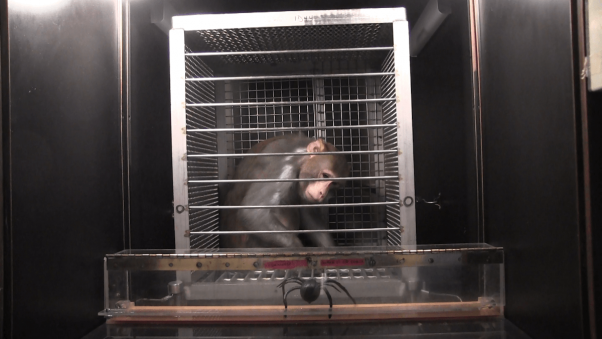Think Spiders and Snakes Are Scary? Try Having Your Brain Sucked Out
It’s in primates’ DNA to fear snakes. And there’s an actual thriller from the ’90s that’s all about spider phobia. But for us, Arachnophobia was just a film. For dozens of monkeys used in government experimenter Elisabeth Murray’s “monkey fright” tests, fake snakes and spiders and other horrors don’t just haunt their dreams—they’re a real-life fright. But it gets worse …
Forget arachnophobia—imagine what it would be like to be forced to endure these 10 things:
1. A Section of Your Skull Being Carved Out
At her National Institutes of Health (NIH) laboratory in Bethesda, Maryland, Murray saws open monkeys’ heads and carves out a section of their skulls.
2. Injections of Toxins Into Your Brain
Once their skulls are hacked open, these monkeys’ brains are exposed, which means Murray is free to inject toxins into the delicate, complex organ.
3. Parts of Your Brain Being Sucked Out
If she doesn’t use toxins to destroy monkeys’ brains, Murray vacuums parts of them out.
4. Being Restrained and Experimented On
During some of these experiments, the monkeys are forced to wear a collar and are bound to a restraint chair for hours at a time, up to five days a week. Experimenters sometimes tie the animals’ arms behind their backs and use a head post (which gets permanently screwed to the skull) to trap them in place.
5. Permanent and Traumatic Brain Damage
Being forced to endure multiple invasive surgeries leaves these monkeys permanently brain-damaged.
6. Confinement to Elaborately Designed Fear Cages
After all this trauma, each monkey is put in a small metal cage that’s held inside a larger box painted black. A guillotine-like door at the front of the cage is suddenly raised, revealing scary, realistic-looking spiders and snakes.
7. Starvation
Experimenters routinely starve monkeys to force them to participate. In one experiment, the animals get no food or water until they perform a required task. Their “reward” is a full day’s worth of food all at once. They then have only 15 minutes to eat it all. It’s called the “Lunch Box” procedure.
8. Isolation
In their natural habitats, monkeys are highly social and cooperative with one another. Many groom their friends to express love and affection. But monkeys used by Murray and her staff are kept completely alone—the brain damage she causes makes it impossible for them to have normal social interactions with others.
9. Murder
How do you get away with murder? Do it in a lab. (Just ask Murray. Most of these monkeys don’t leave her laboratory alive—after she kills the majority of them, following years of torture, she and her colleagues remove their brains and dissect them.)
10. Elisabeth Murray Herself
The scariest thing that a guillotine-like door could reveal upon being raised is the experimenter responsible for all the torment. Murray claims that her twisted “emotional responsiveness” tests may shed light on human neuropsychiatric disorders—but not one treatment or cure for humans has come out of them in 30 years.
ANOTHER SCARY THING IS THAT TAXPAYERS’ DOLLARS ARE BEING WASTED—NEARLY $47 MILLION SINCE 1998.
NIH throws taxpayer money at Murray’s laboratory as if it grows on trees, even though she and her associates acknowledged years ago that the experiments are flawed because stress and other factors may influence the outcome:
[W]e cannot rule out the possibility that environmental factors such as stress contributed to the genetic influence on cognition we report.—Elisabeth Murray and colleagues (in a 2007 paper)

And experts agree—Murray’s monkey fright experiments are completely useless in helping us understand human health.
Don’t Let Experimenters Get Away With Murder
Did you know that a group of monkeys is called a “tribe”? Well, the tribe imprisoned at this Bethesda laboratory is counting on us to help save them from Murray and further torment—we can’t fail them.
Murphy is counting on you to watch his heartbreaking story and share it with everyone you know:
Our mission is to shut this lab down. Click on the button below if you’re with us:




